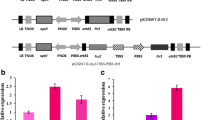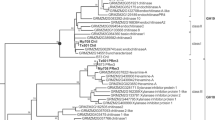Abstract
Phytocystatins are inhibitors of cysteine-proteases from plants putatively involved in plant defence based on their capability of inhibit heterologous enzymes. We have previously characterised the whole cystatin gene family members from barley (HvCPI-1 to HvCPI-13). The aim of this study was to assess the effects of barley cystatins on two phytophagous spider mites, Tetranychus urticae and Brevipalpus chilensis. The determination of proteolytic activity profile in both mite species showed the presence of the cysteine-proteases, putative targets of cystatins, among other enzymatic activities. All barley cystatins, except HvCPI-1 and HvCPI-7, inhibited in vitro mite cathepsin L- and/or cathepsin B-like activities, HvCPI-6 being the strongest inhibitor for both mite species. Transgenic maize plants expressing HvCPI-6 protein were generated and the functional integrity of the cystatin transgene was confirmed by in vitro inhibitory effect observed against T. urticae and B. chilensis protein extracts. Feeding experiments impaired on transgenic lines performed with T. urticae impaired mite development and reproductive performance. Besides, a significant reduction of cathepsin L-like and/or cathepsin B-like activities was observed when the spider mite fed on maize plants expressing HvCPI-6 cystatin. These findings reveal the potential of barley cystatins as acaricide proteins to protect plants against two important mite pests.




Similar content being viewed by others
References
Abraham Z, Martinez M, Carbonero P, Diaz I (2006) Structural and functional diversity within the cystatin gene family of Hordeum vulgare. J Exp Bot 57:4245–4255
Alvarez-Alfageme F, Martinez M, Pascual-Ruiz S, Castañera P, Diaz I, Ortego F (2007) Effects of potato plants expressing a barley cystatin on the predatory bug Podisus maculiventris via herbivorous prey feeding on the plant. Transgenic Res 16:1–13
Alvarez-Alfageme F, Ferry N, Castañera P, Ortego F, Gatehouse AMR (2008) Prey mediated effects of Bt maize on fitness and digestive physiology of the red spider mite predator Stethorus punctillum Weise (Coleoptera: Coccinellidae). Transgenic Res 17:943–954
Bowman CE (1984) Comparative enzymology of economically important astigmatid mites. In: Griffiths DA, Bowman CE (eds) Acarology, Ellis Horwood, Chichester, UK, pp 993–1001
Bradford MM (1976) A rapid and sensitive method for the quantification of microgram quantities of protein utilizing the principle of protein-dye binding. Anal Biochem 72:248–254
Carbonelle S, Hance T, Migeon A, Baret P, Cros-Arteil S, Navajas M (2007) Microsatellite markers reveal spatial and genetic structure of Tetranychus urticae (Acari: Tetranychidae) populations along a latitudinal gradient in Europe. Exp Appl Acarol 41:225–241
Carrillo L, Martinez M, Alvarez-Alfageme F, Castañera P, Smagghe G, Diaz I, Ortego F (2010) A barely cysteine-proteinase inhibitor reduces the performance of two aphid species in artificial diets and transgenic Arabidopsis plants. Transgenic Res doi:10.1007/s11248-010-9417-2
Castagnoli M, Caccia R, Liguori M, Simoni S, Marinari S, Soressi GP (2003) Tomato transgenic lines and Tetranychus urticae: changes in plant suitability and susceptibility. Exp Appl Acarol 31:177–189
Christensen AH, Quail PH (1996) Ubiquitin promoter-based vectors for high-level expression of selectable and/or screenable marker genes in monocotyledoneous plants. Transgenic Res 5:213–218
Croft BA, Van de Baan HE (1988) Ecological and genetic factors: influencing evolution of pesticide resistance in Tetranychid and Phytoseiid mites. Exp Appl Acarol 4:277–300
Fabrick J, Behnke C, Czapla T, Bala K, Rao AG, Kramer KJ, Reeck GR (2002) Effects of a potato cysteine proteinase inhibitor on midgut proteolytic enzyme activity and growth of the southern corn rootworm, Diabrotica undecimpunctata howardi (Coleoptera: Chrysomelidae). Insect Biochem Mol Biol 32:405–415
Fuentealba L (2003) Control de la falsa arañita de la vid (Brevipalpus chilensis Baker) en vid vinifera bajo producción orgánica. Master Project. Pontificia Universidad Católica de Chile
Girard C, Rivard D, Kiggundu A, Kurnet K, Gleddie SC, Cloutier C, Michaud D (2007) A multicomponent, elicitor-inducible cystatin complex in tomato, Solanum lycopersicum. New Phytol 173:841–851
Gutierrez-Campos R, Torres-Acosta J, Saucedo-Arias LJ, Gomez-Lim MA (1999) The use of cysteine proteinase inhibitors to engineer resistance against potyviruses in transgenic tobacco plants. Nat Biotechnol 17:1223–1226
Hamilton KA, Nisbet AJ, Lehane MJ, Taylor MA, Billingsley PF (2003) A physiological and biochemical model for digestion in the ectoparasitic mite, Psoroptes ovis (Acari: Psoroptidae). Int J Parasitol 33:773–785
Hueros G, Rahfeld J, Salamini F, Thompson R (1998) A maize FK506-sensitive inmunophilin, mzFKBP-66, is a peptylproline cis-trans-isomerase that interacts with calmodulin and a 36 kDa cytoplasmic protein. Planta 205:121–131
Jeppson LR, Keifer HH, Baker EW (1975) Mites injurious to economic plants. University of California Press, USA
Kiggundu A, Muchweizi J, Van der Vyer C, Viljoen A, Varster J, Schluter U, Kunert K, Michaud D (2010) Deletereous effects of plant cystatins against the banana weevil Cosmopolites sordidus. Arch Insect Biochem Phsyiol 73:87–105
Konrad R, Connor M, Ferry N, Gatehouse AMR, Babendreier D (2009) Impact of transgenic oilseed rape expressing oryzacystatin-1 (OC-1) and of insecticidal proteins on longevity and digestive enzymes of the solitary bee Osmia bicornis. J Insect Physiol 55:305–313
Lalitha S, Shade RE, Murdock LL, Bressan RA, Hasegawa PM, Nielsen SS (2005) Effectiveness of recombinant soybean cysteine proteinase inhibitors against selected crop pests. Comp Biochem Physiol 140:227–235
Lantz MS, Ciborowski P (1994) Zymographic techniques for detection and characterization of microbial proteases. Meth Enzymol 235:563–594
Lara P, Ortego F, Gonzalez-Hidalgo E, Castañera P, Carbonero P, Diaz I (2000) Adaptation of Spodoptera exigua (Lepidoptera: Noctuidae) to barley trypsin inhibitor BTI-CMe expressed in transgenic tobacco. Transgenic Res 9:169–178
Li Y, Romeis J (2010) Bt maize expressing Cry3Bb1 does not harm the spider mite, Tetranychus urticae, or its ladybird beetle predator, Stethorus punctillum. Biol Control 56:157–164
Lilley CJ, Urwin PE, Johnston KA, Atkinson HJ (2004) Preferential expression of a plant cystatin at nematode feeding sites confers resistance to Meloidogyne incognita and Globodera pallida. Plant Biotech J 2:3–12
Margis R, Reis EM, Villeret V (1998) Structural and phylogenetic relationships among plant and animal cystatins. Arch Biochem Biophys 359:24–30
Martinez M, Diaz I (2008) The origin and evolution of plant cystatins and their target cysteine proteinases indicate a complex functional relationship. BMC Evol Biol 8:198
Martinez M, Lopez-Solanilla E, Rodriguez-Palenzuela P, Carbonero P, Diaz I (2003) Inhibition of plant-pathogenic fungi by the barley cystatin Hv-CPI (gene Icy) is not associated with its cysteine-proteinase inhibitory properties. Mol Plant–Microbe Interact 16:876–883
Martinez M, Diaz-Mendoza M, Carrillo L, Diaz I (2007) Carboxy terminal extended phytocystatins are bifunctional inhibitors of papain and legumain cysteine proteinases. FEBS Lett 581:2914–2918
Martinez M, Cambra I, Carrillo L, Diaz-Mendoza M, Diaz I (2009) Characterization of the entire cystatin gene family in barley and their target cathepsin L-like cysteine-proteases, partners in the hordein mobilization during seed germination. Plant Physiol 151:1531–1545
McCafferty HRK, Moore PH, Zhu Y (2006) Improved Carica papaya tolerance to carmine spider mite by the expression of Manduca sexta chitinase transgene. Transgenic Res 15:337–347
McCafferty HRK, Moore PH, Zhu Y (2008) Papaya transformed with the Galanthus nivalis GNA gene produces a biologically active lectin with spider mite control activity. Plant Sci 175:385–393
Michaud D, Cantin L, Raworth DA, Varin TC (1996) Assessing the stability of cystatin/cysteine proteinase complexes using mildy-denaturing gelatine-polyacrylamide gel electrophoresis. Electrophoresis 17:74–79
Nisbet AJ, Billingsley PF (2000) A comparative survey of the hydrolytic enzymes of ectoparasitic and free-living mites. Int J Parasitol 30:19–27
Nissen MS, Kumar GNM, Youn B, Knowles DB, Lam KS, Ballinger WI, Knowles NR, Kang CH (2009) Characterization of Solanum tuberosum multicystatin and its structural comparison with other cystatins. Plant Cell 2:861–875
Novillo C, Castañera P, Ortego F (1997) Characterization and distribution of chymotrypsin-like and other digestive proteases in Colorado potato beetle larvae. Arch Insect Biochem Physiol 36:181–201
Obrist LB, Klein H, Dutton A, Bigler F (2006) Assessing the effects of Bt maize of the predatory mite Neoseiulus cucumeris. Exp Appl Acarol 38:125–139
Oerke EC (2006) Crop losses to pests. J Agric Sci 144:31–43
Oñate-Sanchez L, Vicente-Carbajosa J (2008) DNA-free RNA isolation protocols for Arabidopsis thaliana, including seeds and siliques. BMC Res Notes 1:93
Ortego F, Novillo C, Castañera P (1996) Characterization and distribution of digestive proteases of the stalk corn borer, Sesamia nonagrioides Lef (Lepidoptera: Noctuidae). Arch Insect Biochem Physiol 33:163–180
Pernas M, Sanchez-Monge R, Gomez L, Salcedo G (1998) A chestnut seed cystatin differentially effective against cysteine proteinase from closely related pests. Plant Mol Biol 38:1235–1242
Pernas M, Sanchez-Monge R, Sanchez-Ramos I, Lombardero M, Arteaga C, Castañera P, Salcedo G (2000) Der p1 and Der f1, the highly related and major allergens from house mites, are differentially affected by a plant cystatin. Clin Exp Allergy 30:972–978
Ramessar K, Rademacher T, Sack M, Stadlmann J, Platis D, Steigler G, Labrou N, Altmann F, Ma J, Stoger E, Capell T, Christou P (2008) Cost-effective production of a vaginal protein microbicide to prevent HIV transmission. Proc Natl Acad Sci USA 105:3727–3732
Ribeiro APO, Pereira EJC, Galvan TL, Picanzo MC, Picoli EAT, da Silva DJH, Fari MG, Otoni WC (2006) Effect of eggplant transformed with oryzacystatin gene on Myzus persicae and Macrosiphum euphorbiae. J Appl Entomol 130:84–90
Rovenska GZ, Zemek R, Schmidt EU, Hilbeck A (2005) Altered host plant reference of Tetranychus urticae and prey preference of its predator Phytoseiulus persimilis (Acari: Tetranychidae, Phytoseiidae) on transgenic Cry3Bb-eggplants. BioControl 33:293–300
Salvesen G, Nagase H (1989) Inhibition of proteolytic enzymes. In Beynon R, Bond JS (eds): Proteolytic Enzymes: A Practical Approach. Oxford: IRL Press at Oxford University Press, pp 83–104
Stubbs MT, Laber B, Bode W, Huber R, Jerala R, Lenarcic B, Turk V (1990) The refined 2.4 A X-ray crystal structure of recombinant human stefin B in complex with the cysteine proteinase papain: a novel type of proteinase inhibitor interaction. EMBO J 9:1939–1947
Taylor B, Powell A (1982) Isolation of plant DNA and RNA. Focus 4:4–6
Walker AJ, Urwin PE, Atkinson HJ, Glen DM, Shewry PR (1999) Transgenic Arabidopsis leaf tissue expressing a modified oryzacystatin shows resistance to the field slug Deroceras reticulatum (Muller.) Transgenic Res 8:95–103
Acknowledgments
We are grateful to Dr. Vicente Marco (Universidad de la Rioja, España) and Dr. Marina Gambardella (Pontificia Universidad Católica de Chile, Chile) for providing the colonies of T. urticae and the B. chilensis lyophilized samples, respectively. We thank Dr. Christou and Dr. Capell from the University of Lleida (Spain) for their support on the maize stable transformation. The financial support from the Spanish Ministerio de Ciencia e Innovación (project BFU2008-01166), the Agencia Española de Cooperación Internacional para el Desarrollo (Project A/023680/09) and the Spanish Ministerio de Medioambiente y Medio Rural y Marino is gratefully acknowledged.
Author information
Authors and Affiliations
Corresponding author
Additional information
Communicated by Q. Zhao.
Rights and permissions
About this article
Cite this article
Carrillo, L., Martinez, M., Ramessar, K. et al. Expression of a barley cystatin gene in maize enhances resistance against phytophagous mites by altering their cysteine-proteases. Plant Cell Rep 30, 101–112 (2011). https://doi.org/10.1007/s00299-010-0948-z
Received:
Accepted:
Published:
Issue Date:
DOI: https://doi.org/10.1007/s00299-010-0948-z




